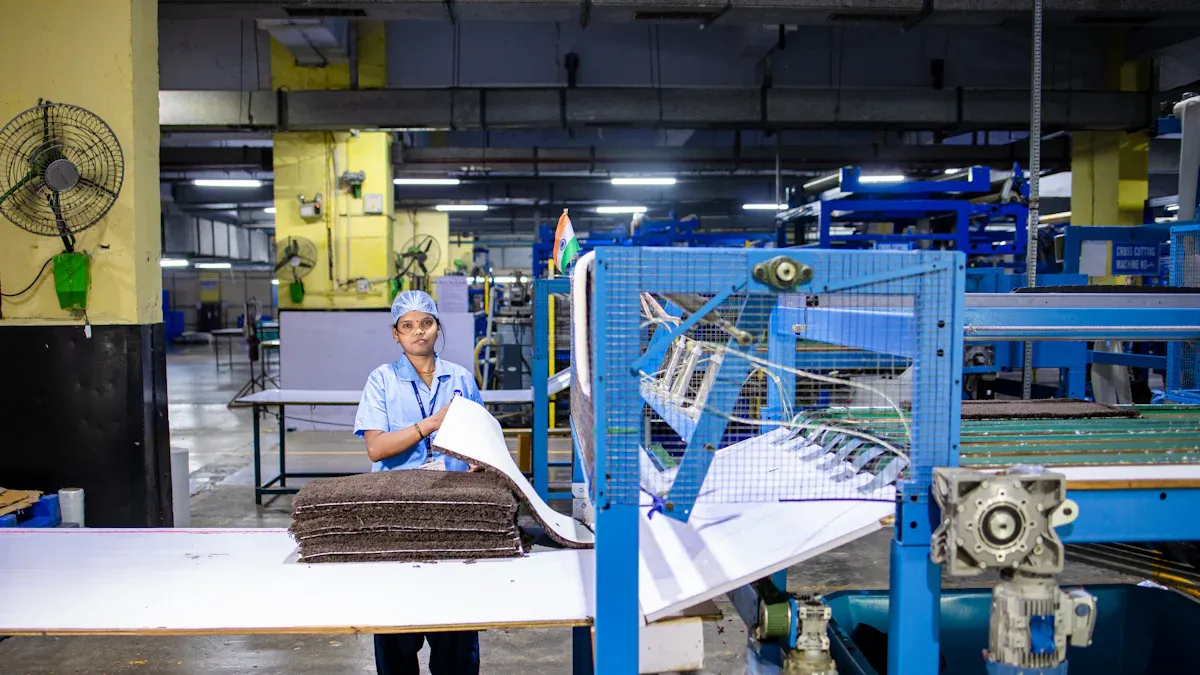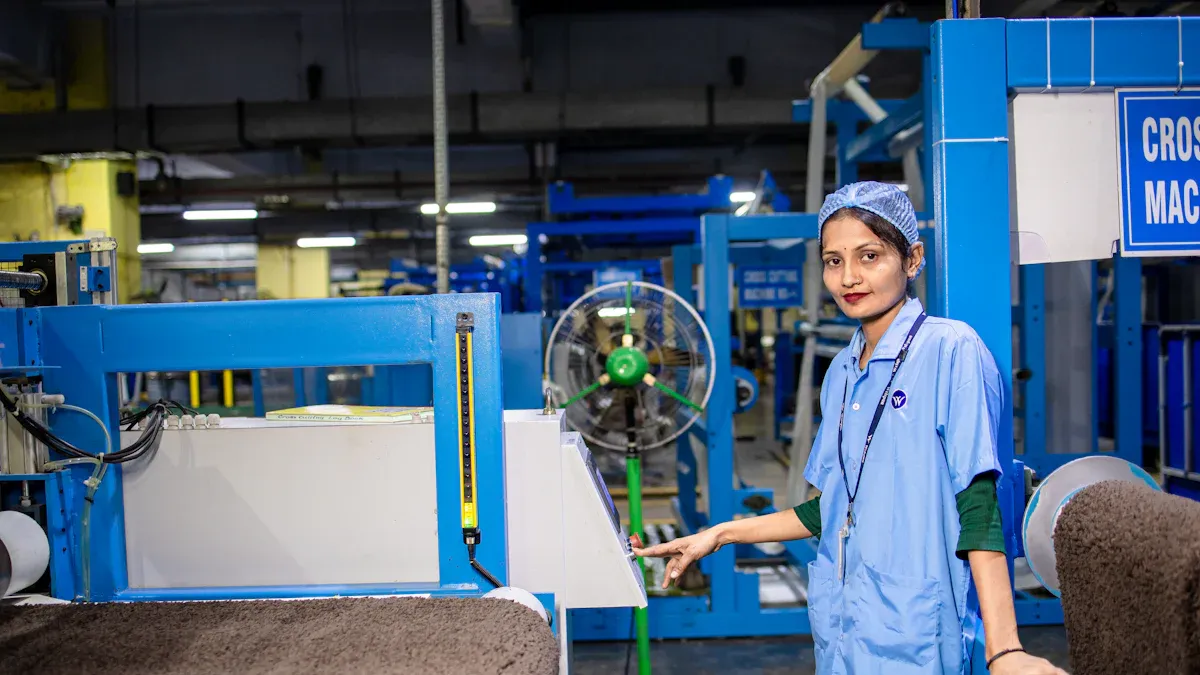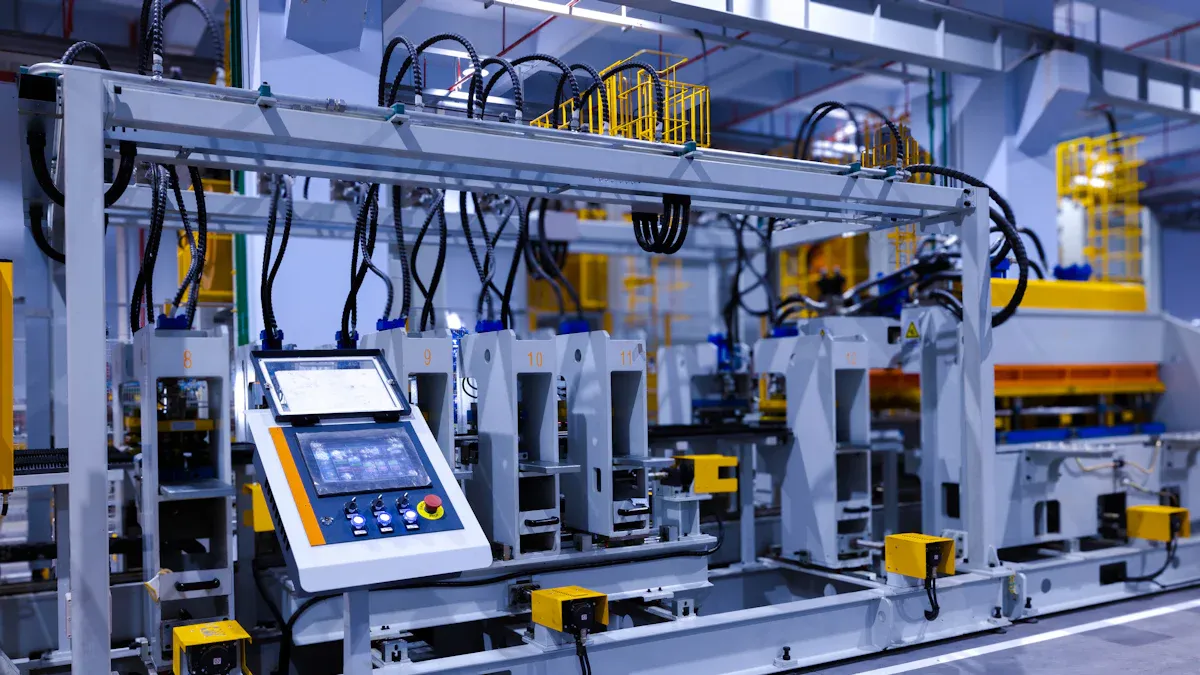
Overmolding combines different materials to create stronger, more functional products. This technique enhances durability and improves how products perform in daily use. For example, the demand for overmolded cables and connectors is rising, with the global market projected to grow from $6.3 billion in 2023 to $10.7 billion by 2032. Overmolding techniques also support industries like automotive and medical devices, where reliability is critical. These innovations allow you to enjoy products that last longer, feel better, and work more efficiently.
Overmolding is a manufacturing process where one material is applied over another to create a single, cohesive product. This technique often uses materials like rubber or plastic to cover a base part, known as the substrate. The process involves placing the substrate into a mold and injecting a second material over or around it. As the materials cure, they bond together to form a durable and functional product.
Common material combinations include thermoplastic over thermoplastic, thermoplastic over metal, and silicone over plastic. Each pairing serves a specific purpose, such as improving grip, enhancing durability, or adding aesthetic appeal. Techniques like insert molding, two-shot molding, and co-injection overmolding are commonly used to achieve these results.
Overmolding plays a vital role in modern manufacturing. It enhances product functionality by combining the strengths of different materials. For example, a tool handle made with a hard plastic core and a soft rubber exterior offers both strength and comfort. This process also improves product aesthetics, reduces the need for additional assembly, and increases durability.
Industries like aerospace, electronics, and medical equipment rely on overmolding to create innovative solutions. Products designed with this technique often feature ergonomic designs, making them easier and more comfortable to use. Despite its benefits, overmolding requires careful planning to ensure material compatibility and proper bonding.
Compared to other manufacturing methods, overmolding offers unique advantages. Traditional techniques often require assembling multiple parts, which can increase production time and cost. Overmolding eliminates this step by integrating materials during the manufacturing process. This reduces complexity and enhances product reliability.
However, overmolding does come with challenges. It demands precise design and tooling, which can be costly. Material options may also be limited, depending on the application. Despite these hurdles, overmolding remains a preferred choice for creating durable, functional, and visually appealing products.

Overmolding techniques create products that can withstand demanding conditions. By combining materials, you get multi-material components that offer superior strength and durability. For example, overmolding allows manufacturers to produce high-performance seals that resist wear and tear. These seals are commonly used in automotive and industrial applications, where reliability is essential.
The process also enhances shock absorption properties in products like protective cases and tool grips. When you use overmolded parts, you benefit from their ability to endure impacts and vibrations. This durability ensures that products last longer, reducing the need for frequent replacements. Overmolding is especially valuable in industries where safety and performance are critical.
Overmolding improves how products feel and function in your hands. Soft rubber handles, for instance, provide a comfortable grip, making tools and devices easier to use. This ergonomic advantage is particularly important for products that require prolonged handling, such as medical devices or industrial tools.
User testing highlights the benefits of overmolding. The handle design of the new auto-injector pen outperformed all previous injection devices during user studies. This shows how overmolding techniques enhance usability and comfort. When products are designed with ergonomics in mind, you experience less strain and greater efficiency during use.
Overmolding offers unmatched design flexibility, allowing manufacturers to create visually appealing products. You’ll notice this in items like automotive steering wheels, which feature sleek designs and improved grip. Smartphone cases also benefit from overmolding, offering a combination of durability and aesthetic appeal.
Consumer feedback highlights how overmolding transforms everyday products. Medical device handles become more ergonomic and visually appealing. Appliance grips and bicycle grips are redesigned for better user experience and aesthetics. Overmolding techniques enable manufacturers to combine functionality with style, giving you products that look as good as they perform.
Overmolding significantly improves cost and time efficiency in the manufacturing process. By combining multiple materials into a single operation, it eliminates the need for assembling separate parts. This streamlined approach reduces production steps, saving both time and resources. For example, instead of attaching a rubber grip to a plastic handle manually, overmolding integrates these materials during production. This method not only speeds up manufacturing but also ensures a stronger bond between materials.
You benefit from overmolding's ability to reduce waste. Traditional manufacturing often involves cutting and shaping materials, which can leave behind excess scraps. Overmolding minimizes this waste by using precise molds that shape materials directly into their final form. This precision reduces material costs and contributes to a more sustainable production process.
Modern technologies, such as Industry 4.0, further enhance the efficiency of overmolding. These technologies use real-time data and advanced analytics to optimize production. For instance:
- Manufacturers can monitor the process in real time to identify and resolve issues quickly.
- Advanced analytics help predict maintenance needs, reducing downtime and keeping production on schedule.
These innovations make overmolding a cost-effective choice for creating durable and functional products.
Overmolding also reduces labor costs. Since the process combines materials during production, it eliminates the need for additional assembly workers. This reduction in manual labor not only lowers expenses but also decreases the likelihood of human error. As a result, you receive products that are both high-quality and affordable.
The time savings offered by overmolding translate into faster delivery of products to the market. When manufacturers can produce items more quickly, they can meet consumer demand more effectively. This efficiency benefits industries like automotive and consumer electronics, where speed and reliability are crucial.
Choosing the right overmolding materials is essential for creating durable and functional products. Different material combinations offer unique advantages, depending on the application. For example, thermoplastics are often paired with metals or rigid plastics to enhance strength and flexibility. Rubber over rigid plastic is another common combination, providing a soft-touch surface for improved grip and comfort.
Here’s a quick overview of some popular overmolding materials and their benefits:
| Material Type | Advantages | Performance Metrics |
|---|---|---|
| Composite Overmolding | Reduced cycle time, lower tooling costs | Improved performance, minimal scrap |
| Thermoplastic Elastomers | Excellent flexibility, soft-touch feel | High durability, ergonomic design |
| Silicone | Heat resistance, biocompatibility | Ideal for medical applications |
When selecting materials, you must consider overmolding material compatibility. This ensures a strong bond between layers and prevents product failure during use.
Material bonding plays a critical role in the success of overmolding. Several factors can impact how well materials adhere to each other. Surface energy is one of the most important considerations. Materials with higher surface energy tend to bond more effectively. You can measure this using water contact angle (WCA) tests, which assess the quality of the surface for bonding.
Other critical factors include:
- Surface Preparation: Cleaning the substrate removes contaminants that could weaken the bond.
- Temperature Control: Maintaining the right temperature during the process ensures optimal adhesion.
- Design Features: Sharp transitions between materials improve bonding, while feathered edges may reduce strength.
By addressing these factors, you can achieve better results when bonding rubber to metal substrates or bonding rubber to plastic substrates.
The rubber overmolding process requires precise adhesion techniques to ensure a durable bond. Substrate preparation is the first step. Clean inserts lead to stronger adhesion, so overmolding should occur immediately after production to avoid contamination. Proper vent design is also crucial. It prevents air entrapment, which can weaken the bond.
Temperature management is another key factor. Gradually heating the thermoplastic elastomer (TPE) to its optimal melt temperature improves adhesion strength. Additionally, a sharp shut-off design between the TPE and the substrate enhances bonding rubber onto substrates. These techniques are essential for creating high-quality multi-component parts.
If you’re considering custom rubber overmolding services, ensure the provider uses these best practices. This guarantees reliable results and long-lasting products.

Overmolding has revolutionized product design across various industries. By combining different materials into cohesive components, it enhances durability, functionality, and aesthetics. Let’s explore how overmolding techniques are applied in consumer electronics, automotive, and medical sectors.
Overmolding plays a crucial role in the development of consumer electronics and wearable devices. It improves product durability, ergonomics, and visual appeal, making these devices more user-friendly and long-lasting. For instance, overmolding materials like thermoplastic elastomers (TPEs) are commonly used to create soft-touch surfaces on headphones, fitness trackers, and smartphone cases. These surfaces not only feel comfortable but also provide a secure grip, reducing the risk of accidental drops.
The market for overmolding services in this sector is growing rapidly.
- The global overmolding service market is expected to expand from USD 1.2 billion in 2024 to USD 2.5 billion by 2033.
- This growth reflects a compound annual growth rate (CAGR) of 9.2% between 2026 and 2033.
This surge highlights the increasing demand for multi-material molded parts that enhance both functionality and aesthetics in consumer electronics. As a result, you can expect more innovative and reliable devices in the future.
In the automotive industry, overmolding techniques are widely used to create durable and ergonomic components. These techniques allow manufacturers to combine overmolding materials like rigid plastics and soft elastomers, resulting in multi-material composite parts that improve both functionality and user experience. For example, car interiors often feature overmolded handles, buttons, and gear knobs that provide a comfortable grip and tactile feedback.
Here’s a closer look at some key applications in this sector:
| Application | Description | Benefits |
|---|---|---|
| Handles and Buttons | Durable and ergonomic components for vehicle interiors. | Enhanced functionality and aesthetic appeal. |
| Car Tail-lights | Integration of multiple color parts into a single cohesive component. | Aesthetically pleasing and durable. |
| Gear Knobs and Door Handles | Combination of a strong core with a soft outer layer for improved grip. | Improved user experience and tactile feedback. |
These applications demonstrate how overmolding materials enhance both the performance and appearance of automotive components. By integrating multiple materials into a single part, manufacturers reduce assembly time and improve product reliability. This ensures that vehicles not only look great but also perform efficiently.
In the medical field, overmolding is essential for creating safe, ergonomic, and visually appealing devices. Overmolding materials like silicone and TPEs are often used to add non-slip surfaces and soft-touch grips to surgical tools and durable medical equipment. These features improve usability and ensure patient safety during medical procedures.
Overmolding enhances the sensory aspects of medical devices, such as grip, texture, and tactile feedback. For example:
- Handles for surgical tools become more comfortable and easier to control.
- Non-slip areas on medical equipment reduce the risk of accidents.
These improvements align with regulatory standards that prioritize safety and usability in medical devices. By using overmolding techniques, manufacturers can produce high-quality products that meet the stringent demands of the healthcare industry.
Overmolding has transformed the design and performance of industrial tools and machinery. By combining materials into a single component, this technique enhances durability, functionality, and user experience. You’ll find overmolding used in products like power tools, gardening equipment, and heavy machinery, where reliability and comfort are essential.
One of the key benefits of overmolding in industrial tools is its ability to improve grip and reduce user fatigue. For example, power tool handles often feature a rigid plastic core covered with a soft rubber layer. This combination provides strength while ensuring a comfortable grip during extended use. Overmolding also adds shock absorption, which protects internal parts from damage caused by vibrations or impacts.
Durability is another major advantage. Overmolded components resist wear and tear better than traditional designs. This makes them ideal for demanding environments like construction sites or manufacturing facilities. For instance, gardening tools with overmolded grips last longer and perform better under heavy use. These tools maintain their functionality even in harsh conditions, such as exposure to moisture or extreme temperatures.
The operational data below highlights how overmolding benefits various industries, including industrial tools and machinery:
| Industry | Benefits of Overmolding | Examples of Applications |
|---|---|---|
| Automotive | Enhances durability, functionality, and safety in components. | Impact-resistant bumpers, ergonomic grips, sensors |
| Medical Devices | Improves reliability and safety by encapsulating electronics in biocompatible materials. | Blood glucose meters, medical device housings |
| Household Products | Provides ergonomic designs and improved grip, enhancing user experience. | Kitchen utensils, power tools, gardening tools |
In industrial tools, overmolding also simplifies the manufacturing process. By integrating multiple materials into a single operation, manufacturers reduce the need for assembling separate parts. This not only saves time but also ensures a stronger bond between materials, resulting in more reliable products. You benefit from tools that are both high-performing and cost-effective.
Overmolding continues to drive innovation in industrial tools and machinery. As technology advances, you can expect even more durable, ergonomic, and efficient tools designed to meet the demands of modern industries.
Recent innovations in overmolding machinery have transformed how manufacturers create multi-material components. Advanced automation and refined process control now allow for greater precision and efficiency. For example, robotic arms equipped with miniaturized overmolding systems can extract components with unmatched accuracy. These systems also monitor and adjust parameters in real time, ensuring consistent quality throughout the manufacturing process.
New techniques like micro-injection molding and thin-wall injection molding have further enhanced the capabilities of overmolding machinery. These methods enable the production of intricate designs and lightweight components without compromising strength. Additionally, hybrid technologies, such as combining 3D printing with overmolding, have opened new possibilities for creating complex structures. These advancements make it easier for you to access durable and functional products tailored to your needs.
Automation has revolutionized the overmolding manufacturing process by reducing production times and improving consistency. Real-time monitoring systems now detect and resolve issues instantly, minimizing downtime. This ensures that every product meets high-quality standards without delays. For instance, inline overmolding of pultrusions within robotic cells has streamlined production, allowing manufacturers to produce more components in less time.
The integration of smart technologies has also improved efficiency. Automated systems can now handle multi-material combinations with precision, reducing the need for manual intervention. This not only lowers labor costs but also eliminates errors caused by human oversight. As a result, you benefit from products that are both reliable and affordable.
Sustainability has become a key focus in overmolding techniques. Manufacturers are increasingly using eco-friendly overmolding materials, such as bio-based plastics and recycled polymers. These materials reduce environmental impact while maintaining the durability and functionality you expect. For example, the automotive industry now prioritizes lightweight, sustainable components to improve fuel efficiency and reduce emissions.
Innovations like resin transfer molding and reaction injection molding have also contributed to sustainability. These processes minimize waste by using precise molds and efficient material distribution. Additionally, the shift toward transparent production practices ensures that you can trust the environmental responsibility of the products you use. Overmolding continues to evolve, offering solutions that balance performance with sustainability.
Overmolding techniques redefine how products are designed and manufactured. By combining materials, you gain lightweight yet strong structures that perform reliably in demanding applications. Process simulation tools now predict structural performance with greater accuracy, reducing trial and error during design. Experimental findings show how input parameters influence interface strength, paving the way for more durable and efficient products. As technology advances, overmolding continues to drive innovation, offering sustainable solutions for multi-material designs across industries.
Overmolding involves layering one material over another to create a single part. Insert molding, on the other hand, embeds a pre-made component (like metal) into the mold before injecting plastic. Both techniques enhance durability and functionality but serve different design purposes.
Yes, overmolding works well with metal substrates. It creates a strong bond between the metal and the overmolded material, such as rubber or plastic. This combination improves durability and adds features like grip or insulation to the final product.
Overmolding adds soft-touch materials like rubber to hard surfaces. This improves grip, reduces strain, and enhances comfort during use. Products like tool handles and medical devices benefit from this ergonomic design, making them easier and safer to use.
Overmolding can be eco-friendly when manufacturers use sustainable materials like recycled plastics or bio-based polymers. The process also reduces waste by eliminating the need for additional assembly, making it a more sustainable manufacturing option.
Industries like automotive, medical, consumer electronics, and industrial tools benefit significantly. Overmolding enhances product durability, functionality, and aesthetics, making it ideal for applications requiring high performance and reliability.